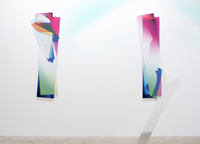New York is a city awash in information. If your body was a receiver can you imagine how overwhelmed by senseless Facebook updates and spam mail it would be? It goes without saying that the more connected we are the more unavoidable digital reality becomes. This does not exclude the white walls of the art gallery. Artie Vierkant‘s first solo exhibition Image Object at Higher Pictures on the Upper East Side is proof of this.
Vierkant is one of a group of photographers and programmers who look increasingly to the internet as part and parcel of their practice. At first his identity as a “web artist” might not be so obvious, nor should he be pinned with this label only. His practice seems to fluctuate between mediums to the point of aggression. Its his ability to collide the internet and real world that appears to define his temperament. The work on view at Higher Pictures comes from a larger ongoing project of photoshopped abstraction series, titled Image Object. The artist explains:
“Image Objects are a series of works which exist somewhere between physical sculpture and altered documentation images. Each piece begins its life as a digital file of which countless variations exist. These are then rendered as UV prints on sintra and precision cut to the form of the piece to create photographic prints with the depth and presence of a sculpture. Each time the pieces are documented officially by the artist or by a physical publication and or on the Internet the documentation becomes a separate work in itself, incorporating elements of collage techniques commonly used in professional image retouching aestheticised digital watermarks and more.”
The five sculptural works on view are connected by their preoccupation with light and neon color. The sculptures lead a double life. In the gallery they have a strange optical quality. Viewed online they float in eery back lit brilliance. The difference provides a case study for how the medium effects the message. Incandescent screen shots pulled from somewhere within Vierkant’s mind’s eye. As he works, individual instances are time stamped and deemed “finished.” The process continues, an onscreen ballet of geometric color. This is a time lapsed performance that bridges the space over the keyboard; the realm between bodily experience and raw digital information.
Vierkant’s static objects are meaningless if not understood for what they are: end notes in a larger opus, one without finite location or time signature. Were I unfamiliar with the artist, I would probably find the minimal display at Higher Pictures confusing. Even with the gallery press release offering an explanation, the four white walls seem expectant as if the work on display is not quite real. There seems to be more at work than first meets the eye. They incite curiosity and beg for a google search and a visit to the artist’s website. The artist understands that most people will never view his artwork “in person” but see them reproduced online or in print. His website itself serves as part promotional device, part archive, and part work of art. The art on view at the gallery is from one of several ongoing projects that the artist works on parallel to one another.
Possible Objects is an open textual project, a grouping of suggestions for possible sculptures. I imagine they are a version of Laurence Wiener for the Linux generation. Each textual idea is realized with re-purposed Ikea furniture. The artist’s Similar Object project is a photo collage of images that are visually similar to the work from his Possible Object series. The artist is also comfortable working soley on the internet; his browwwwser.com pulls images and pages from the artist’s own website as well as a selection of blogs and tumblelogs. Each image is displayed on the screen for roughly five seconds. We are given a stream of consciousness look at the artist’s internet existence. There is little time for contemplation, and it is frustrating, sure, but appropriate. Vierkant seems to construct all of his projects in a way that are compatible with the way we view images today. They predict audience participation: re-blogging, photo shopping, and unintentional distortion.
In his 1972 Ways of Seeing John Berger predicted a future in which bulletin “boards will replace art museums.” If the reality which Berger predicted ended up as Pinterest then Vierkant seems to be trying to reclaim that space for the artist. While the work on view is young and not fully formed — the artist is only 26 — it seems to strike a chord with this particular moment in time. I am reminded of Fluxus artists who prized the dissemination of experience and information over objects. While previous generations might have sought to do away with objects, or Pictures Generation artists like Barbara Kruger and Richard Prince sought to appropriate and bend their meaning, Vierkant has surrendered himself to the mortality of his own authorship. The content within this exhibition is not invested within the objects themselves but their power as touchstones of digital experience. We are moored in a stream of information, privy to how the images that inhabit our lives are subject to constant change. What the artist seems to be trying to point out is the speed of change, defined by the distortion of information transferred between files, objects, and photography. If the digital age represents the birth of a prosthetic memory for man then maybe this is a celebration of its growing senility.
Artie Vierkant‘s Image Object continues at Higher Pictures (980 Madison Avenue, Upper East Side, Manhattan) until October 27.
More information available at: http://hyperallergic.com/59010/fluxus-for-the-linux-generation/

